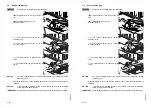
0
608
.USA
E 42
The principal duty of the operator is the safe operation of the powered industrial truck
in accordance with the instructions covered in the training program.
Failure to observe the safety regulations when operating the industrial truck or
improper use or maintenance of a powered industrial truck can have the following
consequences:
– Death or serious injury to the operator or to other people;
– Damage to the industrial truck or to other property.
The training program should focus on the safe and appropriate use of the industrial
truck, with the goal of preventing injury to the operator or to other people and property
damage. To this end the following topics should be covered:
1. General information about the industrial truck(s) to be operated by the trainee,
including:
– Technical data on the powered industrial truck, including differences between
industrial trucks used in the area of work;
– Differences in comparison to a car;
– Meaning of the information on the nameplate, including rated load capacity,
warnings and instructions attached to the industrial truck;
– Operating instructions and warnings set out in the Operating Manual for the
industrial truck, together with inspection and maintenance instructions to be
followed by the operator;
– Type of drive motor and its features;
– Type of steering;
– Braking response and braking distance, laden and unladen;
– Visibility to front and rear, laden and unladen;
– Load capacity when handling loads, weight and load center distance;
– Stability characteristics, laden and unladen, and with and without attachments;
– Position of controls, function, operation, recognition of symbols;
– Possible load-handling equipment, attachments; transport of loads;
– Filling and charging the battery;
– Safety devices and barriers for certain types of industrial truck;
– Other features of a particular industrial truck;
2. The operating environment and its influence on the operation of the industrial
truck, including:
– Floor surface and nature of the sub-floor, including temporary conditions;
– Ramps and inclines, laden and unladen;
– Equipment for filling and charging the battery;
– Use of "classified" industrial trucks in areas presenting a risk of fire or explosion as
defined in ANSI / NFPA 505.
– Narrow gangways, doors, overhead cables and pipe systems, and other enclosed
areas;
– Areas in which the industrial truck may possibly be operated alongside other
powered industrial trucks, vehicles or pedestrians;
– Use and load capacity of elevators;
– Other special operating conditions and hazards that the operator could encounter.
0
608
.USA
E 42
The principal duty of the operator is the safe operation of the powered industrial truck
in accordance with the instructions covered in the training program.
Failure to observe the safety regulations when operating the industrial truck or
improper use or maintenance of a powered industrial truck can have the following
consequences:
– Death or serious injury to the operator or to other people;
– Damage to the industrial truck or to other property.
The training program should focus on the safe and appropriate use of the industrial
truck, with the goal of preventing injury to the operator or to other people and property
damage. To this end the following topics should be covered:
1. General information about the industrial truck(s) to be operated by the trainee,
including:
– Technical data on the powered industrial truck, including differences between
industrial trucks used in the area of work;
– Differences in comparison to a car;
– Meaning of the information on the nameplate, including rated load capacity,
warnings and instructions attached to the industrial truck;
– Operating instructions and warnings set out in the Operating Manual for the
industrial truck, together with inspection and maintenance instructions to be
followed by the operator;
– Type of drive motor and its features;
– Type of steering;
– Braking response and braking distance, laden and unladen;
– Visibility to front and rear, laden and unladen;
– Load capacity when handling loads, weight and load center distance;
– Stability characteristics, laden and unladen, and with and without attachments;
– Position of controls, function, operation, recognition of symbols;
– Possible load-handling equipment, attachments; transport of loads;
– Filling and charging the battery;
– Safety devices and barriers for certain types of industrial truck;
– Other features of a particular industrial truck;
2. The operating environment and its influence on the operation of the industrial
truck, including:
– Floor surface and nature of the sub-floor, including temporary conditions;
– Ramps and inclines, laden and unladen;
– Equipment for filling and charging the battery;
– Use of "classified" industrial trucks in areas presenting a risk of fire or explosion as
defined in ANSI / NFPA 505.
– Narrow gangways, doors, overhead cables and pipe systems, and other enclosed
areas;
– Areas in which the industrial truck may possibly be operated alongside other
powered industrial trucks, vehicles or pedestrians;
– Use and load capacity of elevators;
– Other special operating conditions and hazards that the operator could encounter.
Summary of Contents for ETR 314
Page 1: ...Operating instructions 50 452 907 ETR 314 320 u 06 06 11 09 07 08 E Manual de instrucciones...
Page 7: ...0608 USA I 4 0608 USA I 4...
Page 9: ...0606 USA A 2 0606 USA A 2...
Page 24: ...D 9 0107 USA D 9 0107 USA...
Page 26: ...D 11 0107 USA D 11 0107 USA...
Page 103: ...0107 USA F 10 0107 USA F 10...
Page 123: ...0708 USA G 20 0708 USA G 20...
Page 135: ...0608 E I 4 0608 E I 4...
Page 137: ...0606 E A 2 0606 E A 2...
Page 152: ...D 9 0107 E D 9 0107 E...
Page 154: ...D 11 0107 E D 11 0107 E...
Page 225: ...0608 E E 66 0608 E E 66...
Page 235: ...0107 E F 10 0107 E F 10...
Page 255: ...0708 E G 20 0708 E G 20...






























